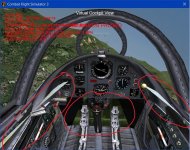SweetFX versus Reshade
A couple of years ago I discovered that I needed to run SweetFX with AnKor's shaders for G-Sync to work in CFS3. I had tried to install the more up to date version called Reshade back then, but it wouldn't run at all so I reverted back to SweetFX for my 16 different installs. In most cases I didn't want/need any special effects so I created a null SweetFX profile that had everything turned off, and G-Sync would still be working fine.
When I recently installed MAW-43 I found that even before I got around to adding SweetFX to that install that G-Sync was working just fine. I'm not sure if it was an Nividia Driver Update, Windows 10 Update, or the newer d3d8.dll from AnKor that did the trick, but it was nice to know that I didn't need SweetFX any longer.
That prompted me to try the latest version of Reshade again, and sure enough, it was now mostly working okay (no DOF functions) with CFS3 (MAW-43 install). It warns you when you do the install that you will need an open source d3d8.dll that Reshade has as an optional add-on, but I just used the one already provided by AnKor and it ran fine. (I didn't want to risk losing all of our wonderful new functionality in CFS3 by using the generic file)
When I do have special effects turned on in-game I typically want to produce the same look that I get by post-processing a saved image in PhotoShop. My method is to do an Image-Adjustments-Auto Contrast, followed by an Unsharp Mask with settings of 20% strength, 30 pixel radius, Threshold 0 (High Local Contrast Enhancement). After trying a variety of shader filter and function combinations I finally hit on one that very closely matches what I get in Photoshop.
In SweetFX it's:
#define USE_LIFTGAMMAGAIN 1
#define RGB_Lift float3(0.82,0.82,0.82)
#define RGB_Gamma float3(1.075,1.075,1.125)
#define RGB_Gain float3(1.085,1.085,1.085)
In Reshade it's:
Effects=LiftGammaGain.fx
Techniques=LiftGammaGain
TechniqueSorting=LeiFx_Tech,AdaptiveFog,AdaptiveSharpen,AmbientLight,ASCII,BloomAndLensFlares,Border,Cartoon,Chromakey,CA,Clarity,ColorMatrix,Colourfulness,AdvancedCRT,Curves,Daltonize,Deband,KNearestNeighbors,NonLocalMeans,DepthHaze,DisplayDepth,RingDOF,MagicDOF,GP65CJ042DOF,MatsoDOF,MartyMcFlyDOF,DPX,EGAfilter,Emphasize,HDR,MotionBlur,FilmGrain,FilmGrain2,FilmicAnamorphSharpen,FilmicPass,Mode1,Mode2,Mode3,FXAA,GaussianBlur,GlitchB,HighPassSharp,HQ4X,Levels,LiftGammaGain,LightDoF_AutoFocus,LightDoF_Far,LightDoF_Near,LumaSharpen,LUT,MagicBloom,Monochrome,MultiLUT,MXAO,Nightvision,Nostalgia,PerfectPerspective,ChromaticAberration,ReflectiveBumpmapping,Tint,SMAA,SurfaceBlur,Technicolor,Technicolor2,TiltShift,Tonemap,UIMask_Top,UIMask_Bottom,Vibrance,Vignette
[LiftGammaGain.fx]
RGB_Lift=0.820000,0.820000,0.820000
RGB_Gamma=1.075000,1.075000,1.125000
RGB_Gain=1.085000,1.0850000,1.085000
The result is that the real time image gains clarity (a hint cooler, brighter and more contrast).
The only difference I see between SweetFX and Reshade using this profile so far is that Reshade drops about 3 FPS, while SweetFX has no slow down at all.
Reshade does provide more filters than SweetFX did, and is the basis for Nvidia's new FreeStyle Ansel features. However, some of the filters available in Reshade run quite a bit slower (-25FPS) on my system than the equivalent ones in SweetFX did, and combinations of even the ones that don't have much impact on FPS can quickly kill the performance. Having said that, the results can be amazing if you have the time to play with all the settings and options to create the look you want.





 At least it's easy to switch between presets.
At least it's easy to switch between presets.